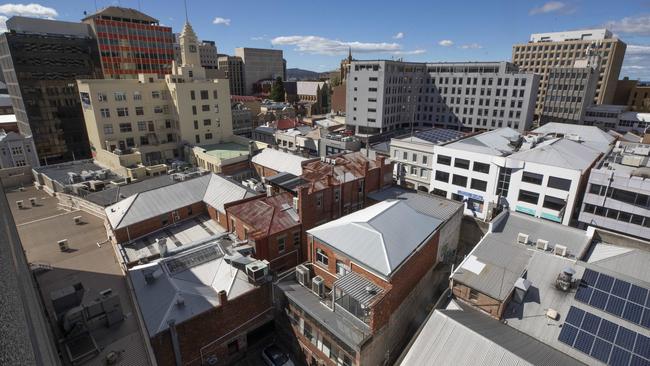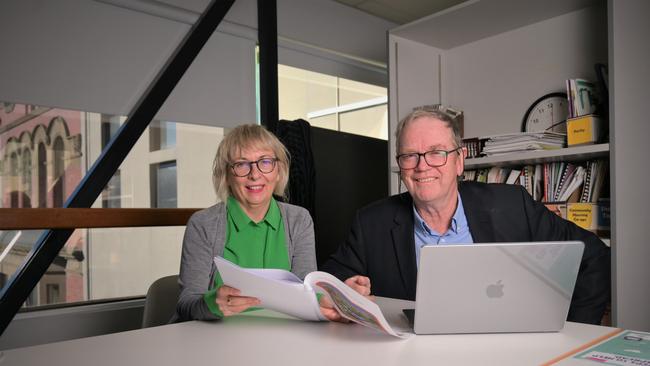Shelter Tas CEO Pattie Chugg says planning changes are needed to combat developer onselling
There are many factors which has led to Tasmania’s housing crisis, and one group says change is needed to increase supply. What they think will help.

Tasmania
Don't miss out on the headlines from Tasmania. Followed categories will be added to My News.
The head of Tasmania’s peak housing body says changes are needed to Tasmania’s planning systems to enable more homes to be built during a time of great need.
The comments come after the Mercury reported there were 500 approved dwellings across several multi-unit projects in Hobart City, which had not yet progressed to the building stage.
It’s something one expert said could be due to onselling or ‘flipping’, where developers obtain permits for sites, only to put the property on the market.
On Monday, Shelter Tas CEO Pattie Chugg said there was a need for change.
“When so many Tasmanians need affordable homes now, why is the system allowing others to delay availability because of speculation to maximise profits?” Ms Chugg said.
“As we continue to face this housing crisis across the state, it’s time we make effective change to the planning system ensure the delivery of homes as quickly as possible.”

The organisation has previously called for measures to be introduced to encourage more building to increase housing stock.
“Shelter Tas, in its submission to the Tasmanian Housing Strategy, has recommended the need for the introduction of strategies to reduce and eliminate land banking, such as date limits to development approvals so that unused approvals expire if not acted upon,” she said.
“To effectively ensure land is used for housing, land speculation must be actively combated.
“We need to keep the pipeline of new construction working effectively by using all available levers to ensure this.”
Ms Chugg said Hobart was the least affordable capital city in Australia, once incomes were taken into account.
“The gap between people’s incomes and rising rents continues to increase,” Ms Chugg said.
“We know the best way to alleviate this pressing community issue is to increase the supply of rental properties by the best means possible.”
“In this environment every home matters to members of our community living in housing stress or experiencing homelessness.
On Sunday, Hobart Lord Mayor Anna Reynolds said supply chain issues, costs, and higher interest rates were also factors which influenced developers decisions to sell.
‘500 homes’: Flippers doom Hobart growth to snails pace
October 9, 5am
The business of “flipping” development sites in Hobart’s CBD has resulted in hundreds of potential homes being left in limbo, a practice one professor says is slowing growth.
Housing economist Peter Phibbs said it wasn’t uncommon for developers to obtain approval for large builds, only to put the site on the market after receiving a permit.
“There are a group of developers whose business model is to get control of a site, get a planning permit for the site and onsell it,” Prof. Phibbs said.
“They have no intention of constructing a development.
“They are called in the trade “flippers” because they buy a site and then flip it. All markets have flippers.”

Prof. Phibbs said choosing to flip sites reduced the risks.
“They don’t have to go the trouble of having to obtain construction finance for a site, go through the risks of a large construction project and the risk of not being able to sell all the apartments,” he said.
“They only have to spend some money on preparing a development [application], which compared to the construction of a large development is relatively modest.”
Prof. Phibbs said Hobart’s housing market could look very different if builds were instead commenced and completed instead of stalled.
“If we had less flippers and more traditional developers who construct projects we would have more housing supply in Hobart which would provide more choice for households,” he said.
“The additional supply would also put downward pressure on prices and rents.”
Hobart Lord Mayor Anna Reynolds said if builds had commenced, it could mean hundreds of homes added to Hobart’s housing stock.
“There are nearly 500 approved dwellings in numerous multi-unit projects that we’ve approved, but have not commenced. That’s a very significant number of homes in the pipeline, but it is disappointingly slow,” she said.

“There’s no obligation for Council to be informed when there’s a change of owner, but sometimes we learn of the change.
“Sometimes our staff become aware of new owners when there’s an application to extend the life of a planning permit for another two years.”
Ms Reynolds said it seemed multi-unit projects were harder to get off the ground in Tasmania.
“We have a very small number of builders able to build larger multistorey residential projects,” she said.
“Also the supply chain issues and costs are more significant as an island with Bass Strait costs. Then there’s higher interest rates and the need to finance the project with sales prior to commencing. These are all factors.
“It seems the slightly smaller apartment projects come to fruition faster that the bigger ones. “The bigger projects seem to be the ones that change hands and may be where property speculators have been involved.”





